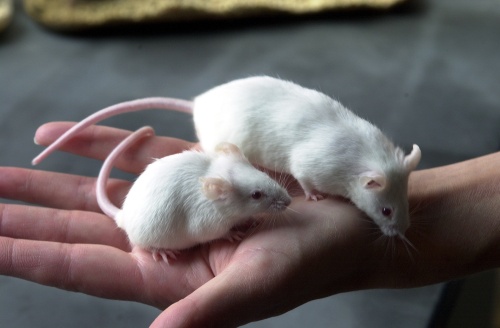A natural anti-cancer mechanism that causes cells to stop dividing and go into limbo also drives the aging process, according to a study in mice that found removing the cells slows the physical decline that comes with age.
The breakthrough answers a riddle about the effect of the cells that refuse to die, though they no longer multiply, dodging scientists for five decades. The “deadbeat” cells, in a state known as senescence, accumulate over time and produce chemicals that damage tissue and trigger inflammation. The results, published yesterday in the journal Nature, show for the first time these cells play a pivotal role in the development of cataracts, muscle weakness and other byproducts of aging.
Researchers led by Jan van Deursen from the Mayo Clinic in Rochester, Minnesota, genetically engineered mice so they aged at five times the normal rate. Their senescent cells were also made sensitive to a normally harmless drug, enabling the researchers to destroy the cells with a medicine that did no damage elsewhere in the animal’s body.
 |
(MCT) |
“The clearance of these senescent cells, which are basically a byproduct of a mechanism to prevent us from developing tumors, improved the function of organs and tissues and in general led to better health,” said van Deursen, a molecular biologist and professor of cellular senescence, in a telephone interview. “We got more insight into why we age. Now that we know these senescent cells contribute to the process, we can think about ways to remove them.”
The area is ripe for exploration by pharmaceutical and biotechnology companies, van Deursen said. If researchers can find a drug that kills senescent cells, it may alter the way doctors approach diseases of the elderly, he said.
Currently, ailments such at cataracts or joint pain are treated separately. One therapy that can reverse the symptoms of aging could target the entire field, allowing a much broader and beneficial effect, he said.
“If you are successful at clearing the senescent cells, that would have a health benefit,” he said. “You could treat age-related disabilities as a group. That has advantages and makes it worth an investment.”
Investigators may also target the immune system to capitalize on the new findings. In the young, senescent cells are flushed by a strong immune system. As people age, their immune systems weaken and the ability to eliminate the cells diminishes, the researchers said. Now that it appears these cells are detrimental, doctors can look into strengthening the immune system so it is more powerful even at an advanced age.
The researchers examined the mice for cataracts, muscle wasting, strength and levels of fat deposits that shrink with age and cause wrinkles. Untreated mice had an aged and frail appearance, while those injected with the drug to kill the senescent cells seemed healthy and vital. They were less likely to have cataracts and more able to exercise, van Deursen said.
“An important goal isn’t just to extend life, but to improve the quality of life, especially at the end of life,” van Deursen said. “People can stay independent and active for a longer period of time, and reduce their dependence on the health-care system.”
The study used genetically engineered mice with senescent cells that carry a molecule called caspase 8. When the molecule was activated with drugs, it drilled a hole in the cells and killed them, according to scientists at the Mayo Clinic’s Robert and Arlene Kogod Center on Aging in Rochester, Minnesota.
“By attacking these cells and what they produce, one day we may be able to break the link between aging mechanisms and predisposition to diseases like heart disease, stroke, cancers and dementia,” said James Kirkland, the center’s head and a co- author of the report, in a statement. (Bloomberg)
<한글기사>
"주름 걱정 끝? 생쥐서 노화증세 차단 성공"
美연구진 "노화세포 제거하자 노화증세 안 나타나"
"항노화 분야 20년 연구에 큰 진전" 평가
평생 탱탱한 피부와 단단한 근육, 좋은 시력을 유지하고 싶은 것은 남녀를 떠나 모든 인간의 욕망이다.
이 거짓말 같은 일이 실현될 가능성을 보여주는 동물실험 결과가 공개됐다고 뉴 욕타임스(NYT)와 BBC 등이 3일 일제히 보도했다.
미국 메이요클리닉의 대런 J. 베이커 박사와 얀 M. 반되선 박사가 이끄는 연구 진은 체내에서 '노화세포'를 제거한 결과 근육 소실과 백내장 등 대표적 노화증세가 나타나지 않았다고 학술지 '네이처'를 통해 발표했다.
노화세포란 더 이상 분열하지 않는 체내 세포로, 면역 체계에 의해 제거되지만 나이가 늘면서 조금씩 증가해 고령 노인의 경우 전체 세포의 10%를 차지하게 된다.
이 세포들은 기능이 명확히 규명되지 않은 염증성 물질을 분비한다고 알려졌을 뿐 유해성 여부는 확인되지 않았다.
연구진은 이 세포가 노화에 따라 늘어나는 p16-ink4a 단백질의 유전자를 작동시 킨다는 데 착안, 특정 약물을 투여하면 노화세포를 자유롭게 제거할 수 있는 유전자 변형 생쥐를 만들어 노화세포와 노화증세와 연관 관계를 살폈다.
실험 결과 노화세포가 처음부터 제거된 생쥐는 고령에 이르러서도 대표적인 노 화증세인 백내장과 근육 소실이 발생하지 않았으며 운동능력도 더 뛰어난 것으로 나 타났다.
특히 피부의 지방층도 그대로 유지했다.
인간의 노화 증세인 주름살은 피부의 지방층이 소실되기 때문에 생긴다.
또 노화 증세가 진행 중인 생쥐에서 노화세포를 제거하자 이미 생긴 백내장은 없어지지 않았지만 근육과 지방층의 소실을 지연시켰다.
이번 연구로 더 이상 분열하지 않는 세포, 즉 노화세포가 축적되면 실제로 조직 의 노화를 촉진한다는 사실이 밝혀졌다고 외신들은 설명했다.
인체는 생쥐처럼 유전자 조작으로 노화세포를 아예 제거할 수는 없지만 이 세포 에만 선택적으로 작용하는 약물을 개발한다면 각종 퇴행성 질환 치료와 예방, 미용 목적으로 활용할 수 있을 것으로 기대된다.
미국 노스캐롤라이나대학의 노화 전문가인 노먼 E. 샤플리스 박사는 "이 결과에 매우 고무됐다"며 "항노화 분야의 근본적인 발전"이라고 평가했다.
한편 노화세포를 제거한 쥐는 노화증세는 생기지 않았지만, 수명은 연장되지 않 았다.
이는 연구 기간 단축을 위해 수명이 훨씬 짧은 특수한 생쥐를 이용한 데 따른 결과일 수 있어 일반 생쥐 대상 연구를 진행하고 있다고 연구진은 덧붙였다. (연합뉴스)








